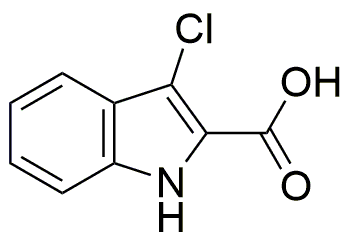3-Chloroindole-2-carboxylic acid is widely utilized in research focused on:
- Pharmaceutical Development: This compound serves as a key intermediate in the synthesis of various pharmaceutical agents, particularly those targeting cancer and neurological disorders, enhancing drug efficacy and specificity.
- Biochemical Research: It is used in studies related to enzyme inhibition and receptor binding, helping researchers understand biological pathways and develop new therapeutic strategies.
- Organic Synthesis: The compound is valuable in organic chemistry for creating complex molecules, allowing chemists to explore new compounds with potential applications in multiple fields.
- Material Science: It contributes to the development of novel materials, such as polymers and coatings, which can exhibit unique properties beneficial for industrial applications.
- Agrochemical Formulation: This chemical is also explored in the formulation of agrochemicals, improving the effectiveness of pesticides and herbicides while minimizing environmental impact.
General Information
Properties
Safety and Regulations
Applications
3-Chloroindole-2-carboxylic acid is widely utilized in research focused on:
- Pharmaceutical Development: This compound serves as a key intermediate in the synthesis of various pharmaceutical agents, particularly those targeting cancer and neurological disorders, enhancing drug efficacy and specificity.
- Biochemical Research: It is used in studies related to enzyme inhibition and receptor binding, helping researchers understand biological pathways and develop new therapeutic strategies.
- Organic Synthesis: The compound is valuable in organic chemistry for creating complex molecules, allowing chemists to explore new compounds with potential applications in multiple fields.
- Material Science: It contributes to the development of novel materials, such as polymers and coatings, which can exhibit unique properties beneficial for industrial applications.
- Agrochemical Formulation: This chemical is also explored in the formulation of agrochemicals, improving the effectiveness of pesticides and herbicides while minimizing environmental impact.
Documents
Safety Data Sheets (SDS)
The SDS provides comprehensive safety information on handling, storage, and disposal of the product.
Product Specification (PS)
The PS provides a comprehensive breakdown of the product’s properties, including chemical composition, physical state, purity, and storage requirements. It also details acceptable quality ranges and the product's intended applications.
Certificates of Analysis (COA)
Search for Certificates of Analysis (COA) by entering the products Lot Number. Lot and Batch Numbers can be found on a product’s label following the words ‘Lot’ or ‘Batch’.
*Catalog Number
*Lot Number
Certificates Of Origin (COO)
This COO confirms the country where the product was manufactured, and also details the materials and components used in it and whether it is derived from natural, synthetic, or other specific sources. This certificate may be required for customs, trade, and regulatory compliance.
*Catalog Number
*Lot Number
Safety Data Sheets (SDS)
The SDS provides comprehensive safety information on handling, storage, and disposal of the product.
DownloadProduct Specification (PS)
The PS provides a comprehensive breakdown of the product’s properties, including chemical composition, physical state, purity, and storage requirements. It also details acceptable quality ranges and the product's intended applications.
DownloadCertificates of Analysis (COA)
Search for Certificates of Analysis (COA) by entering the products Lot Number. Lot and Batch Numbers can be found on a product’s label following the words ‘Lot’ or ‘Batch’.
*Catalog Number
*Lot Number
Certificates Of Origin (COO)
This COO confirms the country where the product was manufactured, and also details the materials and components used in it and whether it is derived from natural, synthetic, or other specific sources. This certificate may be required for customs, trade, and regulatory compliance.


